
Illustrative Math Alignment: Grade 7 Unit 9
Putting it All Together
Lesson 12: Using a Trundle Wheel to Measure Distances
Use the following Media4Math resources with this Illustrative Math lesson.
| Thumbnail Image | Title | Body | Curriculum Topic |
|---|---|---|---|
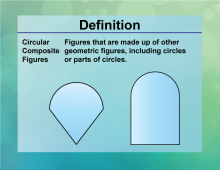
|
Definition--Circle Concepts--Circular Composite Figures | Circular Composite FiguresTopicCircles DefinitionCircular composite figures are shapes that include circles or parts of circles combined with other geometric figures. |
Definition of a Circle |
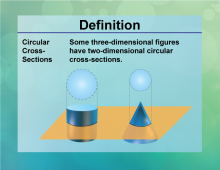
|
Definition--Circle Concepts--Circular Cross-Sections | Circular Cross-SectionsTopicCircles DefinitionCircular cross-sections are the intersections of a plane with a solid that result in a circle. |
Definition of a Circle |

|
Definition--Circle Concepts--Circular Functions | Circular FunctionsTopicCircles DefinitionCircular functions are trigonometric functions that relate angles to ratios of sides in a right triangle. |
Definition of a Circle |
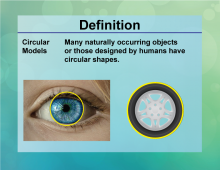
|
Definition--Circle Concepts--Circular Models | Circular ModelsTopicCircles DefinitionCircular models are representations of circular phenomena using mathematical equations and diagrams. |
Definition of a Circle |
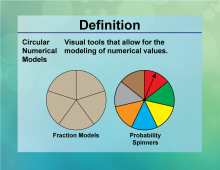
|
Definition--Circle Concepts--Circular Numerical Models | Circular Numerical ModelsTopicCircles DefinitionCircular numerical models use numerical methods to analyze and simulate circular phenomena. |
Definition of a Circle |
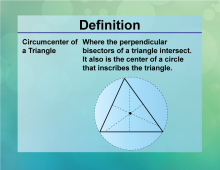
|
Definition--Circle Concepts--Circumcenter of Triangle | Circumcenter of TriangleTopicCircles DefinitionThe circumcenter of a triangle is the point where the perpendicular bisectors of the sides intersect, equidistant from the vertices. |
Definition of a Circle |
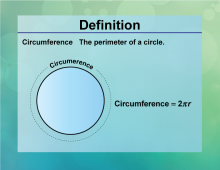
|
Definition--Circle Concepts--Circumference | CircumferenceTopicCircles DefinitionThe circumference of a circle is the distance around the circle, calculated as C = 2πr. DescriptionThe circumference is a fundamental concept in geometry, representing the perimeter of a circle. It is widely used in fields such as engineering, design, and manufacturing, where precise measurements of circular objects are required. The formula C = 2πr |
Definition of a Circle |
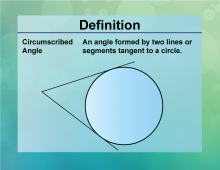
|
Definition--Circle Concepts--Circumscribed Angle | Circumscribed AngleTopicCircles DefinitionA circumscribed angle is an angle formed outside a circle by two intersecting tangents. |
Definition of a Circle |

|
Definition--Circle Concepts--Concentric Circles | Concentric CirclesTopicCircles DefinitionConcentric circles are circles that share the same center but have different radii. |
Definition of a Circle |
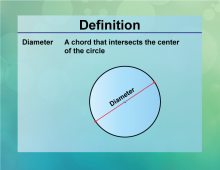
|
Definition--Circle Concepts--Diameter | DiameterTopicCircles DefinitionThe diameter of a circle is a line segment that passes through the center and has its endpoints on the circle, calculated as D = 2πr. DescriptionThe diameter is a fundamental concept in geometry, representing the longest distance across a circle. It is widely used in fields such as engineering, design, and manufacturing, where precise measurements of circular objects are required. The formula D = 2πr |
Definition of a Circle |
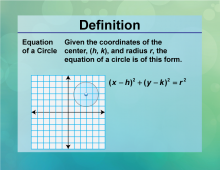
|
Definition--Circle Concepts--Equation of a Circles | Equation of a CircleTopicCircles DefinitionThe equation of a circle in a plane is (x − h)2 + (y − k)2 = r2, where (h , k) is the center and r is the radius. |
Definition of a Circle |
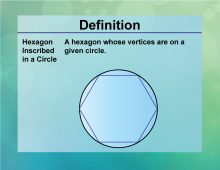
|
Definition--Circle Concepts--Hexagon Inscribed in a Circle | Hexagon Inscribed in a CircleTopicCircles DefinitionA hexagon inscribed in a circle is a six-sided polygon where each vertex touches the circle. |
Definition of a Circle |
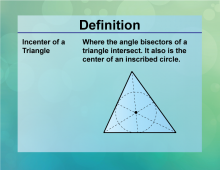
|
Definition--Circle Concepts--Incenter of a Triangle | Incenter of a TriangleTopicCircles DefinitionThe incenter of a triangle is the point where the angle bisectors intersect, equidistant from the sides. |
Definition of a Circle |
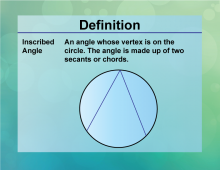
|
Definition--Circle Concepts--Inscribed Angle | Inscribed AngleTopicCircles DefinitionAn inscribed angle is an angle formed by two chords in a circle that share an endpoint. |
Definition of a Circle |

|
Definition--Circle Concepts--Inscribed Angle Theorem | Inscribed Angle TheoremTopicCircles DefinitionThe inscribed angle theorem states that an inscribed angle is half the measure of the central angle that subtends the same arc. |
Definition of a Circle |
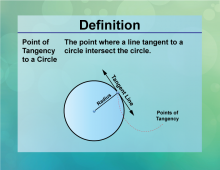
|
Definition--Circle Concepts--Point of Tangency to a Circle | Point of Tangency to a CircleTopicCircles DefinitionThe point of tangency is the point where a tangent line touches the circle. |
Definition of a Circle |
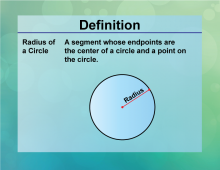
|
Definition--Circle Concepts--Radius of a Circle | Radius of a CircleTopicCircles DefinitionThe radius of a circle is a line segment from the center to any point on the circle. |
Definition of a Circle |
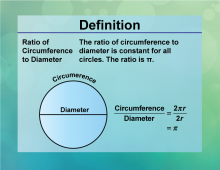
|
Definition--Circle Concepts--Ratio of Circumference to Diameter | Ratio of Circumference to DiameterTopicCircles DefinitionThe ratio of the circumference to the diameter of a circle is the constant π. |
Definition of a Circle |

|
Definition--Circle Concepts--Secant to a Circle | Secant to a CircleTopicCircles DefinitionA secant is a line that intersects a circle at two points. DescriptionSecants are significant in geometry, representing lines that intersect a circle at two distinct points. These lines are used in various applications, such as in design and architecture, where precise measurements of angles and distances are essential. In mathematics, secants are explored in the context of circle theorems, providing insights into the properties of lines and circles. In education, understanding secants helps students develop geometric reasoning and problem-solving skills, which are essential for advanced studies in geometry and trigonometry. |
Definition of a Circle |
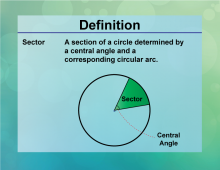
|
Definition--Circle Concepts--Sector | SectorTopicCircles DefinitionA sector is a portion of a circle enclosed by two radii and the arc between them. DescriptionSectors are fundamental in the study of circles, representing a portion of the circle's area. These shapes are used in various applications, such as in design and architecture, where precise measurements of angles and areas are essential. The area of a sector is calculated using the formula A = 1/2r2θ |
Definition of a Circle |
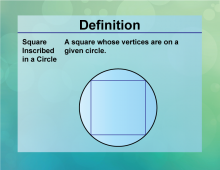
|
Definition--Circle Concepts--Square Inscribed in a Circle | Square Inscribed in a CircleTopicCircles DefinitionA square inscribed in a circle has its vertices touching the circle. |
Definition of a Circle |
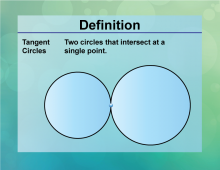
|
Definition--Circle Concepts--Tangent Circles | Tangent CirclesTopicCircles DefinitionTangent circles are two or more circles that intersect at exactly one point. |
Definition of a Circle |
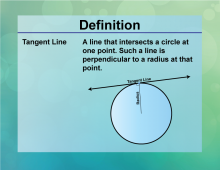
|
Definition--Circle Concepts--Tangent Line | Tangent LineTopicCircles DefinitionA tangent line is a straight line that touches a circle at exactly one point. |
Definition of a Circle |
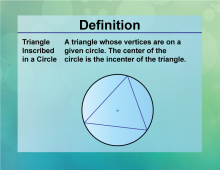
|
Definition--Circle Concepts--Triangle Inscribed in a Circle | Triangle Inscribed in a CircleTopicCircles DefinitionA triangle inscribed in a circle has its vertices on the circle. |
Definition of a Circle |
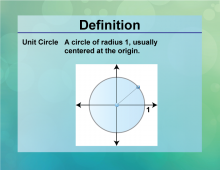
|
Definition--Circle Concepts--Unit Circle | Unit CircleTopicCircles DefinitionThe unit circle is a circle with a radius of one, centered at the origin of the coordinate plane. |
Definition of a Circle |
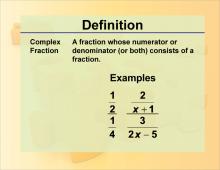
|
Definition--Complex Fraction | Complex FractionTopicFractions DefinitionA complex fraction is a fraction where the numerator, the denominator, or both, contain a fraction themselves. DescriptionComplex fractions are an important concept in the study of fractions and algebra. They appear in various mathematical contexts, particularly when dealing with rational expressions and advanced algebraic operations. Understanding complex fractions is essential for simplifying expressions and solving equations that involve multiple layers of fractions. |
Fractions and Mixed Numbers |

|
Instructional Resource--Geometric Construction--Constructing an Egg Shape | Instructional Resource | Geometric Construction | An Egg Shape
In this instructional resource, we show the steps in constructing an egg shape. In the process, students learn about using common points of tangency to create smooth curves from two different shapes. This activity can be done with pencil, compass, ruler, and grid paper. —PRESS PREVIEW TO VIEW THE ACTIVITY— To see the complete collection of Instructional Resource, click on this link. |
Geometric Constructions with Circles |

|
INSTRUCTIONAL RESOURCE: Math Examples 1 | INSTRUCTIONAL RESOURCE: Math Examples--Circular Area and Circumference
This set of tutorials provides 23 examples of solving for the area and circumferences of circles and sections of circles. This is part of a collection of math examples for a variety of math topics. To see the complete collection of these resources, click on this link. Note: The download is a PPT file.Library of Instructional ResourcesTo see the complete library of Instructional Resources , click on this link. |
Area and Circumference |

|
INSTRUCTIONAL RESOURCE: Pumpkin PI | In this Slide Show, do a hands-on geometry activity to measure π. Note: The download is a PPT file. |
Ratios and Rates |
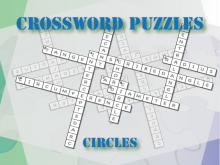
|
Interactive Crossword Puzzle--Circles | Interactive Crossword Puzzle--Circles
This interactive crossword puzzle tests knowledge of key terms on the topic of circles. This is part of a collection of math games and interactives. To see the complete collection of the games, click on this link. Note: The download is the teacher's guide.Related ResourcesTo see additional resources on this topic, click on the Related Resources tab. |
Definition of a Circle |

|
Lesson Plan--Ratios, Proportions, and Percents (Gr 7)--Lesson 1--Introduction to Ratios and Unit Rates | Lesson Plan: Introduction to Ratios and Unit Rates This lesson introduces seventh-grade students to ratios and unit rates, emphasizing their real-world applications. Through engaging activities and problem-solving exercises, students will develop proportional reasoning skills. |
Ratios and Rates |

|
Lesson Plan--Ratios, Proportions, and Percents (Gr 7)--Lesson 2--Unit Rates and Complex Fractions | Lesson Plan: Unit Rates and Complex Fractions This lesson introduces seventh-grade students to unit rates and complex fractions, helping them develop a deeper understanding of proportional relationships and fraction operations. Students will learn to compute unit rates with fractional quantities, simplify complex fractions, and apply these skills to real-world situations such as speed calculations, recipe adjustments, and measurement conversions. |
Ratios and Rates and Applications of Ratios, Proportions, and Percents |
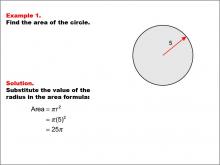
|
Math Example--Area and Perimeter--Circular Area and Circumference: Example 1 | Math Example--Area and Perimeter--Circular Area and Circumference: Example 1TopicGeometry DescriptionThis example presents a circle with a radius of 5 units. The task is to calculate the area of the circle using the given radius. The solution involves substituting the radius value into the area formula: A = π * r^2 = π * (5)^2 = 25π. Understanding circular area and circumference is integral to mastering geometry. Concepts such as calculating areas and circumferences of circles are fundamental, and exercises like these examples not only provide practice but also deepen the understanding of theoretical concepts in a practical way. |
Area and Circumference |
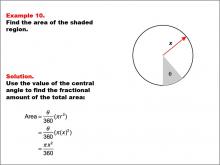
|
Math Example--Area and Perimeter--Circular Area and Circumference: Example 10 | Math Example--Area and Perimeter--Circular Area and Circumference: Example 10TopicGeometry DescriptionThis example presents a circle with radius x and a shaded sector with central angle θ (theta). The task is to express the area of the shaded sector in terms of x and θ. The solution involves using the central angle to find the fractional amount of the total area: A = (θ / 360) * π * x2 = πx2θ / 360. |
Area and Circumference |

|
Math Example--Area and Perimeter--Circular Area and Circumference: Example 11 | Math Example--Area and Perimeter--Circular Area and Circumference: Example 11TopicGeometry DescriptionThis example presents a circle with radius x and a shaded sector with central angle θ (theta). The task is to express the arc length of the shaded region in terms of x and θ. The solution involves using the central angle to find the fractional amount of the circumference: Arc Length = (θ / 360) * (2 * π * x) = (θ * x / 180) * π. |
Area and Circumference |
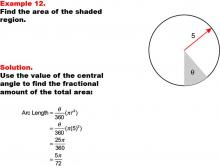
|
Math Example--Area and Perimeter--Circular Area and Circumference: Example 12 | Math Example--Area and Perimeter--Circular Area and Circumference: Example 12TopicGeometry DescriptionThis example features a circle with a radius of 5 units and a shaded sector with central angle θ (theta). The task is to express the area of the shaded sector in terms of θ. The solution involves using the central angle to find the fractional amount of the total area: Area = (θ / 360) * (π * 52) = 25π / 360 * θ = 5π / 72 * θ. |
Area and Circumference |
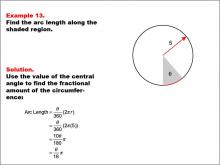
|
Math Example--Area and Perimeter--Circular Area and Circumference: Example 13 | Math Example--Area and Perimeter--Circular Area and Circumference: Example 13TopicGeometry DescriptionThis example presents a circle with a radius of 5 units and a shaded sector with central angle θ (theta). The task is to express the arc length of the shaded region in terms of θ. The solution involves using the central angle to find the fractional amount of the circumference: Arc Length = (θ / 360) * (2 * π * 5) = θ / 18 * π. |
Area and Circumference |
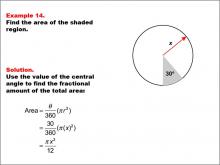
|
Math Example--Area and Perimeter--Circular Area and Circumference: Example 14 | Math Example--Area and Perimeter--Circular Area and Circumference: Example 14TopicGeometry DescriptionThis example features a circle with radius x and a shaded sector with a central angle of 30 degrees. The task is to express the area of the shaded sector in terms of x. The solution involves using the central angle to find the fractional amount of the total area: Area = (30 / 360) * (π * x2) = π * x2 / 12. |
Area and Circumference |
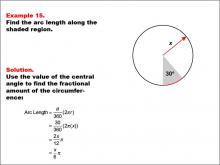
|
Math Example--Area and Perimeter--Circular Area and Circumference: Example 15 | Math Example--Area and Perimeter--Circular Area and Circumference: Example 15TopicGeometry DescriptionThis example presents a circle with radius x and a shaded sector with a central angle of 30 degrees. The task is to express the arc length of the shaded region in terms of x. The solution involves using the central angle to find the fractional amount of the circumference: Arc Length = (30 / 360) * (2 * π * x) = x / 6 * π. |
Area and Circumference |

|
Math Example--Area and Perimeter--Circular Area and Circumference: Example 16 | Math Example--Area and Perimeter--Circular Area and Circumference: Example 16TopicGeometry DescriptionThis example features two concentric circles with radii of 5 and 4 units, and a shaded sector with a central angle of 30 degrees. The task is to calculate the area of the shaded region. The solution involves using the central angle to determine the fractional area difference between the larger and smaller circles: Area = (θ / 360) * (π * r12 - π * r22) = (30 / 360) * (π * 52 - π * 42) = π / 12 * (25 - 16) = 3π / 4. |
Area and Circumference |

|
Math Example--Area and Perimeter--Circular Area and Circumference: Example 17 | Math Example--Area and Perimeter--Circular Area and Circumference: Example 17TopicGeometry DescriptionThis example presents two concentric circles with radii of 5 and 4 units, and a shaded sector with a central angle of 30 degrees. The task is to calculate the perimeter of the shaded region. The solution involves calculating arc lengths based on the central angle and adding straight-line segments between radii: Perimeter = (θ / 360) * (2 * π * r1 + 2 * π * r2) + 2 * (r1 - r2) = (30 / 360) * (2π * 5 + 2π * 4) + 2 * (5 - 4) = 3π / 2 + 2. |
Area and Circumference |
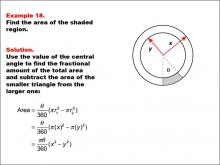
|
Math Example--Area and Perimeter--Circular Area and Circumference: Example 18 | Math Example--Area and Perimeter--Circular Area and Circumference: Example 18TopicGeometry DescriptionThis example features two concentric circles with radii x and y, and a shaded sector with a central angle θ (theta). The task is to express the area of the shaded region in terms of x, y, and θ. The solution uses the central angle to find the fractional area difference between the larger and smaller circles: Area = (θ / 360) * (π * x2 - π * y2) = (θπ / 360) * (x2 - y2). |
Area and Circumference |
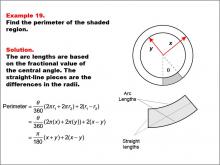
|
Math Example--Area and Perimeter--Circular Area and Circumference: Example 19 | Math Example--Area and Perimeter--Circular Area and Circumference: Example 19TopicGeometry DescriptionThis example presents two concentric circles with radii x and y, and a shaded sector with a central angle θ (theta). The task is to express the perimeter of the shaded region in terms of x, y, and θ. The solution involves calculating arc lengths based on the central angle and adding straight-line segments between radii: Perimeter = (θ / 360) * (2πx + 2πy) + 2(x - y) = π/180 * θ(x + y) + 2(x - y). |
Area and Circumference |

|
Math Example--Area and Perimeter--Circular Area and Circumference: Example 2 | Math Example--Area and Perimeter--Circular Area and Circumference: Example 2TopicGeometry DescriptionThis example features a circle with a radius of 5 units. The objective is to calculate the circumference of the circle using the given radius. The solution involves applying the circumference formula: C = 2 * π * r = 2 * π * (5) = 10π. Circular area and circumference calculations are fundamental in geometry. These examples provide students with practical applications of theoretical concepts, helping them understand the relationship between a circle's radius and its circumference. |
Area and Circumference |
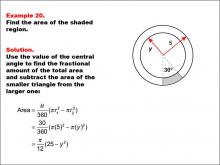
|
Math Example--Area and Perimeter--Circular Area and Circumference: Example 20 | Math Example--Area and Perimeter--Circular Area and Circumference: Example 20TopicGeometry DescriptionThis example features two concentric circles with radii 5 and y, and a shaded sector with a central angle of 30 degrees. The task is to express the area of the shaded region in terms of y. The solution involves calculating the difference between the areas of the larger and smaller circles, accounting for the central angle: Area = π/12 * (25 - y2). |
Area and Circumference |
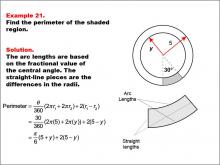
|
Math Example--Area and Perimeter--Circular Area and Circumference: Example 21 | Math Example--Area and Perimeter--Circular Area and Circumference: Example 21TopicGeometry DescriptionThis example features two concentric circles with radii 5 and y, and a shaded sector with a central angle of 30 degrees. The task is to calculate the perimeter of the shaded region. Given a central angle of 30 degrees, radius 5, and unknown radius y, the perimeter is calculated as: Perimeter = π/6 * (5 + y) + 2(5 - y). |
Area and Circumference |
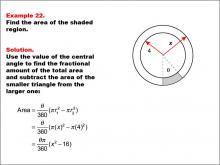
|
Math Example--Area and Perimeter--Circular Area and Circumference: Example 22 | Math Example--Area and Perimeter--Circular Area and Circumference: Example 22TopicGeometry DescriptionThis example presents two concentric circles with radii 4 and x, and a shaded sector with a central angle θ (theta). The task is to express the area of the shaded region in terms of x and θ. The solution uses the central angle to find the fractional area difference between the larger and smaller circles: Area = (θ / 360) * (π * x2 - π * 42) = (θ * π / 360) * (x2 - 16). |
Area and Circumference |
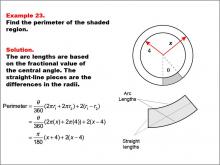
|
Math Example--Area and Perimeter--Circular Area and Circumference: Example 23 | Math Example--Area and Perimeter--Circular Area and Circumference: Example 23TopicGeometry DescriptionThis example features two concentric circles with radii x and 4, and a shaded sector with a central angle θ (theta). The task is to express the perimeter of the shaded region in terms of x and θ. The solution involves calculating arc lengths based on the central angle and adding straight-line segments between radii: Perimeter = (θ / 360) * (2 * π * x + 2 * π * 4) + 2 * (x - 4) = (π / 180) * θ(x + 4) + 2(x - 4). |
Area and Circumference |
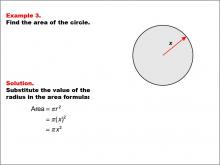
|
Math Example--Area and Perimeter--Circular Area and Circumference: Example 3 | Math Example--Area and Perimeter--Circular Area and Circumference: Example 3TopicGeometry DescriptionThis example introduces a circle with an unknown radius represented by x. The task is to express the area of the circle in terms of x. The solution demonstrates how to use the area formula with a variable radius: A = π * r2 = π * (x)2 = π * x2. Working with variable expressions in geometry helps students transition from concrete to abstract thinking. This example bridges the gap between numerical calculations and algebraic representations, a crucial skill in advanced mathematics. |
Area and Circumference |
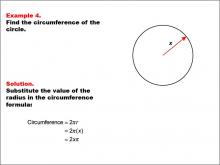
|
Math Example--Area and Perimeter--Circular Area and Circumference: Example 4 | Math Example--Area and Perimeter--Circular Area and Circumference: Example 4TopicGeometry DescriptionThis example presents a circle with an unknown radius represented by x. The task is to express the circumference of the circle in terms of x. The solution demonstrates how to use the circumference formula with a variable radius: C = 2 * π * r = 2 * π * x = 2πx. Understanding circular area and circumference is crucial in geometry. This example helps students transition from concrete numerical values to abstract algebraic expressions, fostering a deeper comprehension of the relationship between a circle's radius and its circumference. |
Area and Circumference |